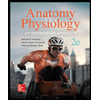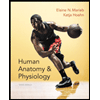
Human Anatomy & Physiology (11th Edition)
11th Edition
ISBN: 9780134580999
Author: Elaine N. Marieb, Katja N. Hoehn
Publisher: PEARSON
expand_more
expand_more
format_list_bulleted
Question
![The image contains text from an educational document, including two tables and associated activity questions related to muscle stimulation experiments.
**Chart 1: Effect of Stimulus Voltage on Active Force**
| Voltage (V) | Active Force (g) |
|-------------|------------------|
| 0.0 | 0.0 |
| 0.2 | 0.0 |
| 0.4 | 0.0 |
| 0.6 | 0.0 |
| 0.8 | 0.0 |
| 1.0 | 0.0 |
| 1.5 | 0.0 |
| 2.0 | 0.0 |
| 2.5 | 0.0 |
| 3.0 | 1.8 |
| 3.5 | 5.0 |
| 4.0 | 7.0 |
**Activity Questions:**
1. For a muscle like the one in this lab, explain the effect of increasing stimulus voltage.
2. How is this effect on a muscle achieved in vivo (in the body) [with the excitability of neurons]?
**Activity 3: The Effect of Stimulus Frequency on Skeletal Muscle Contraction**
- This section instructs users to return to a PhysioEx menu and select activity 2 before starting.
- The experiment involves increasing the frequency of stimulus voltage to determine its effect on muscle force generation.
- Users will follow directions starting on page 23 of the PhysioEx guide for specific instructions.
**Table: Effect of Stimulus Frequency on Active Force**
| Voltage (V) | Frequency (Hz) | Active Force (g) |
|-------------|----------------|------------------|
| 8.5 | 50 | |
| 8.5 | 60 | |
| 8.5 | 90 | |
| 8.5 | 110 | |
| 8.5 | 130 | |
**Activity Questions:**
The document instructs further exploration into the effects of increasing stimulus frequency, suggests a limit to the response, and refers to enhanced muscle simulation in a human body context. Users are encouraged to complete the tables by conducting the experiments as described in the guide.](https://content.bartleby.com/qna-images/question/6ff8cd7d-4774-439c-9bad-526ddcb8f076/8670c584-e699-4ccd-92ec-540a925d0732/msvq0rk_thumbnail.png)
Transcribed Image Text:The image contains text from an educational document, including two tables and associated activity questions related to muscle stimulation experiments.
**Chart 1: Effect of Stimulus Voltage on Active Force**
| Voltage (V) | Active Force (g) |
|-------------|------------------|
| 0.0 | 0.0 |
| 0.2 | 0.0 |
| 0.4 | 0.0 |
| 0.6 | 0.0 |
| 0.8 | 0.0 |
| 1.0 | 0.0 |
| 1.5 | 0.0 |
| 2.0 | 0.0 |
| 2.5 | 0.0 |
| 3.0 | 1.8 |
| 3.5 | 5.0 |
| 4.0 | 7.0 |
**Activity Questions:**
1. For a muscle like the one in this lab, explain the effect of increasing stimulus voltage.
2. How is this effect on a muscle achieved in vivo (in the body) [with the excitability of neurons]?
**Activity 3: The Effect of Stimulus Frequency on Skeletal Muscle Contraction**
- This section instructs users to return to a PhysioEx menu and select activity 2 before starting.
- The experiment involves increasing the frequency of stimulus voltage to determine its effect on muscle force generation.
- Users will follow directions starting on page 23 of the PhysioEx guide for specific instructions.
**Table: Effect of Stimulus Frequency on Active Force**
| Voltage (V) | Frequency (Hz) | Active Force (g) |
|-------------|----------------|------------------|
| 8.5 | 50 | |
| 8.5 | 60 | |
| 8.5 | 90 | |
| 8.5 | 110 | |
| 8.5 | 130 | |
**Activity Questions:**
The document instructs further exploration into the effects of increasing stimulus frequency, suggests a limit to the response, and refers to enhanced muscle simulation in a human body context. Users are encouraged to complete the tables by conducting the experiments as described in the guide.
Expert Solution
This question has been solved!
Explore an expertly crafted, step-by-step solution for a thorough understanding of key concepts.
This is a popular solution
Trending nowThis is a popular solution!
Step by stepSolved in 2 steps

Knowledge Booster
Similar questions
- 39- The firing rate for primary sensory neuron of spindle muscle is: a- High during stretching the muscle. b- Interrupted during extinction the muscle. c- Steady, neither increased nor decreased. d- High during contraction.arrow_forwardThe muscle fibers with the fastest contractions are O slow oxidative O fast oxidative O fast glycolytic O fasciclesarrow_forwardV 0 B 100% 0 7. What muscle is this? by till de 8. What is the specific insertion of muscle #7?arrow_forward
- D Question 2 Events of the contraction cycle arrange in orderly manner 1. Cross Bridge 2. Detachment 3. ATP Hydrolysis 4. Power Stroke 1, 2, 3, 4 O 3,1,4, 2 O 2, 1, 3, 4 O 4, 3, 1, 2arrow_forwardCardiomyocytes differ from skeletal muscle cells in that cardiomyocytes ______. A "do not have actin, myosin, or Z-disk " B do not have their actin and myosin arranged into sarcomeres and myofibrils C cannot have action potentials at a high enough frequency for tetani to occur D have fewer mitochondria and are more reliant on anaerobic respiration E All of the above are true of heart muscle cellsarrow_forwardBoth Tactile Corpuscles and Lamellated Corpuscles are encapsulated and detect different amounts of pressure. Explain why the capsule surrounding these receptors is part of their modality.arrow_forward
- 5. Explain what gives muscle a striated appearance and name the myofilaments and the structures involved (Z disk, H band, I band ect.).arrow_forwardSmooth muscle contraction involves: OA. T-tubules OB. Sarcomeres OC. Myosin Kinase OD. All of the above O E. None of the abovearrow_forwardA&P1 Muscle Tissue Lab Continued.... Label the images below: ARRA APAR Leese Syste Disse of heeee Which bands get smaller during a contraction? Which band stays the same during a contraction? Which filaments form the I band?. What is connected to the M line? What does Titin do? The H band? BARAarrow_forward
- 1. Describe a skeletal muscle fiber's microanatomy, including structures such as the sarcolemma, sarcoplasmic reticulum, transverse tubules, myofibrils (sarcomere structure).arrow_forwardFor each of the following list where waste/solutes/water start and where they end up. Use the renal tubule and blood as the options for the starting and ending points Tubular reabsorption Tubular secretion Water conservationarrow_forwardAnswer is not carrow_forward
arrow_back_ios
arrow_forward_ios
Recommended textbooks for you
 Human Anatomy & Physiology (11th Edition)Anatomy and PhysiologyISBN:9780134580999Author:Elaine N. Marieb, Katja N. HoehnPublisher:PEARSON
Human Anatomy & Physiology (11th Edition)Anatomy and PhysiologyISBN:9780134580999Author:Elaine N. Marieb, Katja N. HoehnPublisher:PEARSON Anatomy & PhysiologyAnatomy and PhysiologyISBN:9781259398629Author:McKinley, Michael P., O'loughlin, Valerie Dean, Bidle, Theresa StouterPublisher:Mcgraw Hill Education,
Anatomy & PhysiologyAnatomy and PhysiologyISBN:9781259398629Author:McKinley, Michael P., O'loughlin, Valerie Dean, Bidle, Theresa StouterPublisher:Mcgraw Hill Education, Human AnatomyAnatomy and PhysiologyISBN:9780135168059Author:Marieb, Elaine Nicpon, Brady, Patricia, Mallatt, JonPublisher:Pearson Education, Inc.,
Human AnatomyAnatomy and PhysiologyISBN:9780135168059Author:Marieb, Elaine Nicpon, Brady, Patricia, Mallatt, JonPublisher:Pearson Education, Inc., Anatomy & Physiology: An Integrative ApproachAnatomy and PhysiologyISBN:9780078024283Author:Michael McKinley Dr., Valerie O'Loughlin, Theresa BidlePublisher:McGraw-Hill Education
Anatomy & Physiology: An Integrative ApproachAnatomy and PhysiologyISBN:9780078024283Author:Michael McKinley Dr., Valerie O'Loughlin, Theresa BidlePublisher:McGraw-Hill Education Human Anatomy & Physiology (Marieb, Human Anatomy...Anatomy and PhysiologyISBN:9780321927040Author:Elaine N. Marieb, Katja HoehnPublisher:PEARSON
Human Anatomy & Physiology (Marieb, Human Anatomy...Anatomy and PhysiologyISBN:9780321927040Author:Elaine N. Marieb, Katja HoehnPublisher:PEARSON

Human Anatomy & Physiology (11th Edition)
Anatomy and Physiology
ISBN:9780134580999
Author:Elaine N. Marieb, Katja N. Hoehn
Publisher:PEARSON

Anatomy & Physiology
Anatomy and Physiology
ISBN:9781259398629
Author:McKinley, Michael P., O'loughlin, Valerie Dean, Bidle, Theresa Stouter
Publisher:Mcgraw Hill Education,

Human Anatomy
Anatomy and Physiology
ISBN:9780135168059
Author:Marieb, Elaine Nicpon, Brady, Patricia, Mallatt, Jon
Publisher:Pearson Education, Inc.,

Anatomy & Physiology: An Integrative Approach
Anatomy and Physiology
ISBN:9780078024283
Author:Michael McKinley Dr., Valerie O'Loughlin, Theresa Bidle
Publisher:McGraw-Hill Education

Human Anatomy & Physiology (Marieb, Human Anatomy...
Anatomy and Physiology
ISBN:9780321927040
Author:Elaine N. Marieb, Katja Hoehn
Publisher:PEARSON